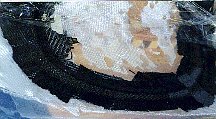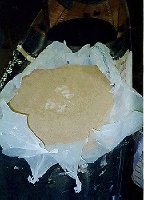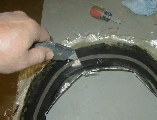
 |
||||
| INDEX | next
|
 |
The
seal-channel: This term refers to the grooved ring that houses a waterproof
rubber gasket and also holds the hatch lid flush with the deck after the
seal becomes compressed. It can be made of plywood or of composite materials. Here again, I chose to make it as a laminate of fiberglass and scraps of graphite. Such channels can be built faster, cheaper and are immeasurably more abuse resistant that their plywood equivalent. Just think how much stuff will be rubbed against and dragged out past these thin flanges. Ruggedness is required here. |
 |
The
photo above shows a fresh lay-up of a composite channel. Using a simple
mold, a bit of epoxy putty and scraps of fiberglass one can make three of
these in one afternoon. Full details are covered in the Manual. Builders of One Ocean Kayaks will also find the construction covered in high resolution photos in the Builders' Pages This photo shows a heap of moist sand weighing down the fresh lay-up. It works somewhat like the technique of 'vacuum bagging'. The sand presses the lay-up against the mold, compressing the fibers together and squeezing out bubbles and excess epoxy. The resulting channel is light and strong. More importantly, it is of the exact shape as the hatch opening with a correctly sized gasket groove molded in it. |
 |
Separate the foam mold gasket from the seal-channel along the edges so it can be scraped out easily without tearing. The gasket here is 1/8"-3/16" thick and the same width as the finished seal. That is about half the thickness of the finished rubber gasket that will seal the hatch later. |
| INDEX |
| Home | Kayak Designs | Kayak Shop | Materials | Kayak Gallery | About us |
| Building Manual | Plans | Sandwich Core | Wood Kayak | Order | |
| Epoxy Test | Abrasion Cloth | Rudder | Resources | Choosing Kayak | Guestbook |
If you notice any problems with the site (i.e. error links, missing images) please, let me know. Thanks
Mail:
Vaclav Stejskal
10 Colonial Court apt. 73
Stoneham, MA. 02180
USA
Tel: 781-481-9261
© 1999
- 2020 Copyright Vaclav Stejskal
All rights reserved
Last page update:
11 January 2020